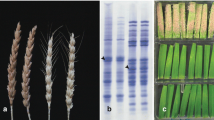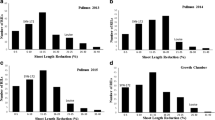Summary
Four cultivars moderately resistant to Philippine isolates of Xanthomonas campestris pv. oryzae races 2, 3, 5 and 6 and highly resistant to race 1 were crossed with two susceptible cultivars and with each other. The F1 populations were as or more susceptible than the least resistant parent cultivar when assessed for lesion length (cm) by clip-inoculating booting plants with two race 2 and one race 6 isolates of X.c. oryzae. The F2 populations showed continuous distributions when assessed with the race 6 isolate PX099, although populations from crosses between moderately resistant cultivars were positively skewed. Mean broad-sense heritability in the F2 was 0.50. Selection for varying levels of resistance was carried out in the F2 and F3 generations. F3 lines selected from the F2 population modes had variances and ranges equal to those selected from the F2 population extremes and larger than the variances of the parent cultivars.
Line selection in the F3 generation was more effective than plant selection in the F3 and in the F2. Realized h2 was 0.39 for line selection in the F3 but only 0.24 for plant selection. A number of lines more resistant than both parents were recovered in crosses between moderately resistant cultivars. Lines more susceptible than both parents were also recovered in crosses between moderately resistant cultivars, but few of these lines were as susceptible as the susceptible cultivars. This indicates that the moderately resistant cultivars had some resistance factor(s) in common. All test cultivars, including the susceptible cultivars, carry few to several factors for quantitative resistance. A model based on nine minor resistance factors is proposed to explain the pattern of transgression found in crosses between the six cultivars.
Similar content being viewed by others
References
Ezuka, A. & O. Horino, 1974. Classification of rice varieties and Xanthomonas oryzae strains on the basis of their differential interactions. Bulletin Tokai—Kiuki National Agric. Exp. Station 27: 1–19.
Kauffman, H.E., A.P.K. Reddy, S.P.Y. Hsieh & S.D. Merca, 1973. An improved technique for evaluating resistance of rice varieties to Xanthomonas oryzae. Plant Disease Reporter 57: 537–541.
Koch, M.F. & J.E. Parlevliet, 1991. Residual effects of the Xa-4 resistance gene in three rice cultivars when exposed to a virulent isolate of Xanthomonas campestris pv. oryzae, Euphytica (in press).
Mather, K. & J.L. Jinks, 1971. Biometrical Genetics. Cornell University Press, Ithaca. 382 pp.
Mew, T.W., 1987. Current status and future prospects of research on bacterial blight of rice. Annual Review Phytopathology 25: 359–382.
Ogawa, T., T. Yamamoto, H. Kaku, S. Taura, G.S. Khush & T.W. Mew, 1988. Resistance to Rice Bacterial Leaf Blight: Report of April 1982–March 1988. Government of Japan and the International Rice Research Institute. 299 pp.
Parlevliet, J.E., 1978. Further evidence of polygenic inheritance of partial resistance in barley to leaf rust, Puccinia hordei. Euphytica 27: 369–379.
Vera Cruz, C.M. & T.W. Mew, 1988. Background resistance to bacterial blight: Lesion expansion. International Rice Research Newsletter. 13(3): 14–15.
Vera Cruz, C.M. & T.W. Mew, 1989. How variable is Xanthomonas campestris pv. oryzae? p. 153–166. In: Bacterial Blight in Rice. International Rice Research Institute. Los Baños, Philippines, 235 pp.
Wasano, K. & M.P. Dhanapala, 1982. Genetic analysis and selection for the polygenic resistance to bacterial leaf blight of rice. Japan Journal Tropical Agriculture 26: 130–139.
Wasano, K. & K. Imoto, 1987. Efficiency of selection for polygenic resistance to bacterial leaf blight of rice and resistance patterns of the polygenic lines selected to the different bacterial strains. Bulletin Faculty Agriculture Saga University 62: 59–78 (in Japanese with English summary).
Yamada, T., 1984. Studies on genetics and breeding of resistance to bacterial leaf blight in rice VI. Inheritance of quantitative resistance of the variety IR28 to bacterial groups II, III, IV of Xanthomonas campestris pv. oryzae of Japan. Japanese J. Breeding 34: 181–190.
Yamada, T., 1986a. Estimates of genetic parameters of quantitative resistance to bacterial leaf blight of rice variety IR26 and their implications in selection. Japanese J. Breeding 36: 112–121.
Yamada, T., 1986b. Effective method of selection for bacterial leaf blight resistance in a hybrid population derived from the cross having rice variety IR28 as a resistance-donor parent. Japanese J. Breeding 36: 274–283.
Yoshimura, A., T.W. Mew, G.S. Khush & T. Omura, 1984. Genetics of bacterial blight resistance in a breeding line of rice. Phytopathology 74: 773–779.
Author information
Authors and Affiliations
Rights and permissions
About this article
Cite this article
Koch, M.F., Parlevliet, J.E. Genetic analysis of, and selection for, factors affecting quantitative resistance to Xanthomonas campestris pv. oryzae in rice. Euphytica 53, 235–245 (1991). https://doi.org/10.1007/BF00023275
Received:
Accepted:
Issue Date:
DOI: https://doi.org/10.1007/BF00023275




